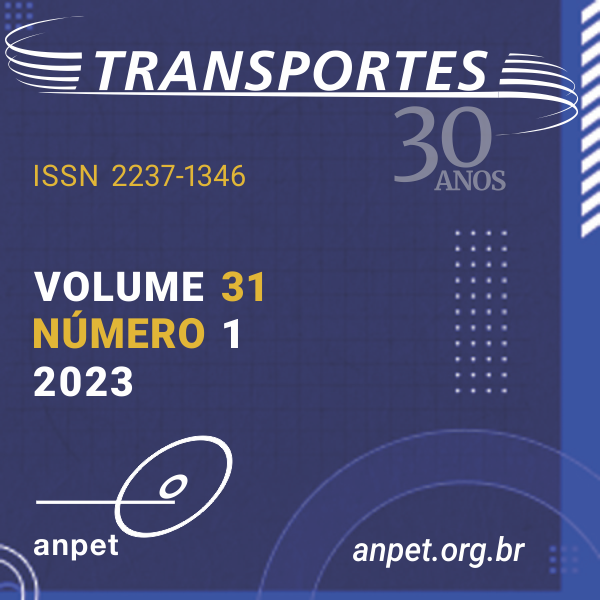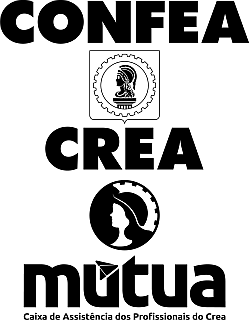Análise da viabilidade da fabricação de blocos intertravados de concreto para pavimentos com o uso de agregados reciclados da construção civil
DOI:
https://doi.org/10.58922/transportes.v31i1.2860Palavras-chave:
Blocos intertravados de concreto, Agregados reciclados, Resíduo de construção e demolição, Métodos de dimensionamentoResumo
O objetivo deste artigo é analisar a viabilidade de utilização de blocos intertravados de concreto, com agregados reciclados de resíduos de construção e demolição, para pavimentação. Primeiro, foi produzido concreto seco, o qual é conhecido por apresentar slump-zero, sendo necessária máquina de vibro-prensa para compactação e desforma imediata. Assim, quatro misturas de concreto seco, REF-0.63, REF-0.73, 50CDW-0.63 e 50CDW-0.73 (os dois primeiros e os dois últimos sem e com agregados reciclados, respectivamente) foram aplicadas com duas relações água/cimento (0.63 e 0.73). Na próxima etapa, foram utilizados métodos de dimensionamento empírico e mecanístico-empírico para pavimento de blocos intertravados, sendo simulada a construção dessa estrutura com avaliação de custos. Os resultados indicaram que a mistura de referência REF-0.73, com mais água, apresentou a maior resistência característica à compressão aos 28 dias (25.34 MPa). Além disso, o pavimento intertravado resultante do dimensionamento mecanístico-empírico, com agregados reciclados nos blocos (mistura 50CDW-0.63), gerou economia da ordem de US$76.000,00 em comparação ao pavimento de blocos de referência (mistura REF-0.73). Por fim, o concreto seco pode apresentar melhor comportamento mecânico com a adição de água e a tecnologia de pavimento intertravado é mais atrativa financeiramente, aplicando método de dimensionamento mecanístico-empírico.
Downloads
Referências
AASHTO (1995) Standard M 145: Specification for Classification of Soils and Soil-Aggregate Mixtures for Highway Construction Purposes. Washington, D.C.: American Association of State Highway and Transportation Officials.
ABNT (2004) Standard NBR 10004: Solid waste – Classification. Rio de Janeiro: Brazilian Technical Standards Association.
ABNT (2005) Standard NBR 9778: Hardened mortar and concrete – Determination of absorption, voids and specific gravity. Rio de Janeiro: Brazilian Technical Standards Association.
ABNT (2008) Standard NBR 9833: Fresh concrete – Determination of the unit weight, yield and air content by the gravimetric test method. Rio de Janeiro: Brazilian Technical Standards Association.
ABNT (2008) Standard NBR 15630: Mortars applied on walls and ceilings – Determination of elasticity modulus by the ultrasonic wave propagation. Rio de Janeiro: Brazilian Technical Standards Association.
ABNT (2011) Standard NBR 15953: Interlocking pavement with concrete units – Execution. Rio de Janeiro: Brazilian Technical Standards Association.
ABNT (2013) Standard NBR 9781: Concrete paving units – Specification and test methods. Rio de Janeiro: Brazilian Technical Standards Association.
ABNT (2017) Standard NBR 16605: Portland cement and other powdered material – Determination of the specific gravity. Rio de Janeiro: Brazilian Technical Standards Association.
ABNT (2021) Standard NBR 16916: Fine aggregate – Determination of density and water absorption. Rio de Janeiro: Brazilian Technical Standards Association.
ABNT (2021) Standard NBR 16917: Coarse aggregate - Determination of density and water absorption. Rio de Janeiro: Brazilian Technical Standards Association.
ABNT (2021) Standard NBR 16972: Aggregates – Determination of the unit weight and air-void contents. Rio de Janeiro: Brazilian Technical Standards Association.
ABNT (2022) Standard NBR 7211: Aggregates for concrete – Requirements. Rio de Janeiro: Brazilian Technical Standards Association.
ACI (2009) Standard 211.3R–02: Guide for Selecting Proportions for No-Slump Concrete. Farmington Hills: American Concrete Institute.
ASTM (2021) Standard C936: Specification for Solid Concrete Interlocking Paving Units. West Conshohocken: American Society for Testing and Materials.
Baird, C. and M. Cann (2011) Environmental chemistry (4th ed.). Porto Alegre: Bookman.
Carvalho, M. D. (1998) Technical Study 27: Paving with precast concrete units (4th ed.). Sao Paulo: Brazilian Portland Cement Association. Available at: <https://abcp.org.br/wp-content/uploads/2016/01/ET-27_Pavimentacao_pecas_premoldadas.pdf> (accessed on 25/01/2022).
Chu, S. H.; C. S. Poon; C. S. Lam and L. Li. (2021) Effect of natural and recycled aggregate packing on properties of concrete blocks. Construction and Building Materials, v. 278, 122247. DOI: 10.1016/j.conbuildmat.2021.122247. DOI: https://doi.org/10.1016/j.conbuildmat.2021.122247
CMAA (2018) DesignPave v2.0 (Version 2.0). Concrete Masonry Association of Australia. Available at: <https://www.cmaa.com.au/DesignPave/Registration> (accessed on 10/02/2022).
Crispim, M. (2018) Entulho volta a ser material de construção [Online]. Available at: <http://agenciaeconordeste.com.br/entulho-volta-a-ser-material-de-construcao/> (accessed on 18/04/2022).
Cruz, L. O. M. (2003) Interlocking Concrete Pavement: Study of Design Elements and Methods. M.Sc. Thesis. Federal University of Rio de Janeiro, Rio de Janeiro. Available at: <http://www.coc.ufrj.br/pt/dissertacoes-de-mestrado/103-msc-pt-2003/1840-luiz-otavio-maia-cruz> (accessed on 20/01/2022).
DNER (1994) Standard DNER–ME 180/94: Soils stabilized with fly ash and hydrated lime – Determination of the simple compressive strength. Brasilia, DF: National Highway Department.
DNIT (2016) Standard DNIT 172/2016–ME: Soils – Determination of the California Bearing Ratio using unworked samples – Test method. Brasilia, DF: National Transport Infrastructure Department.
DNIT (2018) Standard DNIT 134/2018–ME: Pavement – Soils – Determination of the resilient modulus – Test method. Brasilia, DF: National Transport Infrastructure Department.
Francisco, J. T. M.; A. E. Souza and S. R. Teixeira (2019) Construction and demolition waste in concrete: property of pre-molded parts for paving. Cerâmica, v. 65, suppl. 1, p. 22–26. DOI: 10.1590/0366-6913201965S12595. DOI: https://doi.org/10.1590/0366-6913201965s12595
Helene, P. and P. Terzian (1992) Concrete Dosage and Control Manual (1st ed.). Sao Paulo: Pini.
Lilley, A. A. and B. J. Walker (1986) Concrete block paving for heavily trafficked roads and paved areas (5th ed.). London: Cement and Concrete Association.
Luo, W.; S. Liu; Y. Hu; D. Hu; K.W. Kow; C. Pang and B. Li (2022) Sustainable reuse of excavated soil and recycled concrete aggregate in manufacturing concrete blocks. Construction and Building Materials, v. 342, 127917. DOI: 10.1016/j.conbuildmat.2022.127917. DOI: https://doi.org/10.1016/j.conbuildmat.2022.127917
Odemark, N. (1949) Investigations as to the Elastic Properties of Soils and Design of Pavements according to the Theory of Elasticity. Ph.D. Thesis. Statens Vagins Institute, Stockholm. Available at: <http://vti.diva-portal.org/smash/record.jsf?pid=diva2%3A867287&dswid=-1641> (accessed on 11/06/2022).
Ono, B. W.; J. T. Balbo and A. Cargnin (2017) Analysis of the infiltration capacity of unidirectionally jointed concrete block permeable pavement. Transportes, v. 25, n. 3, p. 90–101. DOI: 10.14295/transportes.v25i3.1314. DOI: https://doi.org/10.14295/transportes.v25i3.1314
Özalp, F.; H.D. Yılmaz, M. Kara, Ö. Kaya and A. Şahin (2016) Effects of recycled aggregates from construction and demolition wastes on mechanical and permeability properties of paving stone, kerb and concrete pipes, Construction and Building Materials, v. 110, p. 17–23. DOI: 10.1016/j.conbuildmat.2016.01.030. DOI: https://doi.org/10.1016/j.conbuildmat.2016.01.030
PMSP (2004) Project Instruction 06: Design of pavements with interlocking concrete blocks. Sao Paulo: Sao Paulo City Hall.
Poon, C.S. and D. Chan (2007) Effects of contaminants on the properties of concrete paving blocks prepared with recycled concrete aggregates, Construction and Building Materials, v. 21, n. 1, p. 164–175. DOI: https://doi.org/10.1016/j.conbuildmat.2005.06.031. DOI: https://doi.org/10.1016/j.conbuildmat.2005.06.031
SA (2003) Standard AS/NZS 4456.4: Masonry units and segmental pavers and flags – Methods of test – Determining compressive strength of masonry units. Sydney: Standards Australia.
SEINFRA-CE (2022) Table 027 (without tax). Fortaleza: Secretary of Infrastructure of Ceara. Available at: <https://www.seinfra.ce.gov.br/tabela-de-custos/> (accessed on 22/08/2022).
Shackel, B. (1988) The evolution and application of mechanistic design procedures for concrete block pavements. Proceedings of the III International Conference on Concrete Block Pavement. Rome: SEPT, p. 114–120. Available at:<http://www.sept.org/techpapers/108.pdf> (accessed on 20/01/2022).
Silva, W. B. C. (2020) Analysis of the feasibility of manufacturing interlocking concrete pavement blocks with the use of thermoelectric waste and recycled aggregate from civil construction. M.Sc. Thesis. Federal University of Ceara, Fortaleza. Available at: <https://repositorio.ufc.br/handle/riufc/56811> (accessed on 20/01/2020).
Vasconcelos, S. D. (2016) Evaluation of the heterogeneity of coal ash from the Energia Pecém thermoelectric power plant and its application in pavement granular layers. Monograph. Federal University of Ceara, Fortaleza. Available at: <https://repositorio.ufc.br/handle/riufc/47005> (accessed on 22/08/2022).
Vasconcelos, S. D.; S. H. A. Barroso; F. A. F. Vieira and H. B. F. Almeida (2019) Evaluation of the use of coal ash produced at a thermal power plant in pavement construction. Transportes, v. 27, n. 2, p. 73–89. DOI: 10.14295/transportes.v27i2.1592. DOI: https://doi.org/10.14295/transportes.v27i2.1592
Downloads
Publicado
Como Citar
Edição
Seção
Licença
Copyright (c) 2023 Webert Brasil Cirilo da Silva, Suelly Helena de Araújo Barroso, Antônio Eduardo Bezerra Cabral, Ronaldo Stefanutti, Luís Guilherme de Picado-Santos

Este trabalho está licenciado sob uma licença Creative Commons Attribution 4.0 International License.
Ao submeter um manuscrito para publicação neste periódico, todos os seus autores concordam, antecipada e irrestritamente, com os seguintes termos:
- Os autores mantém os direitos autorais e concedem à Transportes o direito de primeira publicação do manuscrito, sem nenhum ônus financeiro, e abrem mão de qualquer outra remuneração pela sua publicação pela ANPET.
- Ao ser publicado pela Transportes, o manuscrito fica automaticamente licenciado sob a Licença Creative Commons CC BY 4.0. Esta licença permite o seu compartilhamento com reconhecimento da autoria e da publicação inicial neste periódico.
- Os autores têm autorização para assumir contratos adicionais separadamente, para distribuição não exclusiva da versão do trabalho publicada neste periódico (por ex.: publicar em repositório institucional ou como capítulo de livro), com reconhecimento da publicação inicial na Transportes, desde que tal contrato não implique num endosso do conteúdo do manuscrito ou do novo veículo pela ANPET.
- Os autores têm permissão e são estimulados a publicar e distribuir seu manuscrito online (por ex.: em repositórios institucionais ou na sua página pessoal) depois de concluído o processo editorial. Como a Transportes é de acesso livre, os autores são estimulados a usar links para o DOI do artigo nesses casos.
- Os autores garantem que obtiveram todas as permissões necessárias dos empregadores para a publicação e o licenciamento CC BY 4.0 do manuscrito, especialmente se o empregador possuir alguma reivindicação sobre os direitos autorais do manuscrito. Os autores assumem total responsabilidade por questões de direitos autorais relacionadas ao empregador, isentando a ANPET e a Transportes de qualquer responsabilidade relacionada.
- Os autores assumem toda responsabilidade sobre o conteúdo do manuscrito, incluindo as devidas e necessárias autorizações para divulgação de dados coletados e resultados obtidos, isentando a ANPET e a Transportes de toda e qualquer responsabilidade neste sentido.
Última atualização: 27/11/2025











